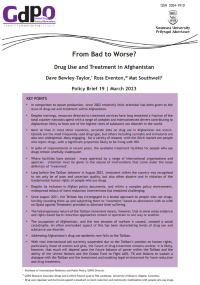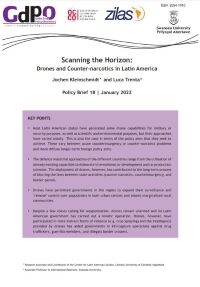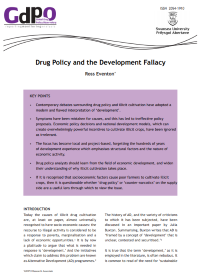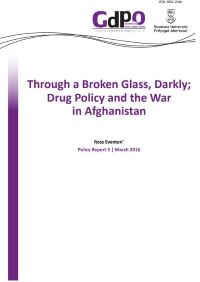The production and transport of illicit drugs is closely connected with violence. As criminal gangs and so-called drug ‘cartels’ attempt to secure trafficking routes, move drugs, and consolidate and expand territories of control, they regularly clash with rival organisations and the state. At the same time, many national security forces have been shown to be linked with traffickers, and violent responses to the trafficking and production of drugs often provide the spark for horrendous levels of violence; as demonstrated in Mexico since 2006. In both cases, it is the population who suffer. Drug production often takes place in insecure areas, including war zones - almost the entire world’s heroin production occurs in a country at war. While violence and conflict have many sources, too often the drugs issue serves as a catch-all, simplifying complex conditions and ignoring the underlying factors that drugs can serve to inflame rather than create. Colombia and Afghanistan are two prominent cases of countries where the ‘war on drugs’ has become enmeshed in a national conflict. In these countries, not only have counter-narcotics policies proven ineffective, they have also had disastrous consequences for the population. New approaches and perspectives are clearly needed. This project focuses on analysing the interplay between drugs and violent conflict, on bringing context to the debate, and on advocating strategies that combat violence while reducing levels of harm and respecting human rights.

 All GDPO material published on this website is licensed under a CC-BY Creative Commons Attribution 4.0 International License.
All GDPO material published on this website is licensed under a CC-BY Creative Commons Attribution 4.0 International License.
Drug Use and Treatment in Afghanistan
GDPO Policy Brief 19, March 2023
Dave Bewley-Taylor, Ross Eventon, Mat Southwell
In comparison to opium production, since 2002 relatively little attention has been given to the issue of drug use and treatment within Afghanistan. Despite warnings, resources directed to treatment services have long remained a fraction of the total counter-narcotics spend with a range of complex and interconnected drivers contributing to Afghanistan likely to have one of the highest rates of substance use disorder in the world. More so than in most other countries, accurate data on drug use in Afghanistan are scarce. Opioids are the most frequently used drug type, but others including cannabis and stimulants are also now widespread. Many engaging - for a variety of reasons -with the illicit market are people who inject drugs, with a significant proportion likely to be living with HIV. In spite of improvements in recent years, the available treatment facilities for people who use drugs remain woefully inadequate. Where facilities have existed – many operated by a range of international organisations and agencies – attention must be given to the nature of interventions that come under the loose definition of ‘treatment’. Long before the Taliban takeover in August 2021, treatment within the country was recognised to not only be of poor and uncertain quality, but also often abusive and in violation of the fundamental human rights of people who use drugs. Despite its inclusion in Afghan policy documents, and within a complex policy environment, widespread rollout of harm reduction interventions has remained challenging. Since August 2021, the Taliban has (re)engaged in a brutal approach to people who use drugs, forcibly rounding them up and subjecting them to ‘treatment’ based on abstinence with no with no Opioid Agonist Treatment provided to alleviate their suffering. The heterogeneous nature of the Taliban movement means, however, that in some areas evidence and rights based harm reduction approaches remain in operation in one way or another. The occupation of Afghanistan, and the two decades of warfare it caused, created a social catastrophe. An often overlooked aspect of this has been skyrocketing levels of drug use and substance use disorder. Addressing Afghanistan’s drug use epidemic now falls to the Taliban. With vital international aid currently suspended due to the Taliban’s position on human rights, particularly those of women and girls, the future of drug treatment remains unclear. It is likely, however, that much will depend upon the future balance of power within the Taliban and the ability of the United Nations and the Global Fund to Fight AIDS, TB and Malaria to sustain a dialogue with the Taliban and the investment and enabling legal environment for harm reduction and drug treatment.
Read the full report here: Drug Use and Treatment in Afghanistan
Remote warfare in the ‘backyard’:
the US government, counternarcotics, and remote warfare in Latin America
GDPO Policy Report 8, June 2022
Jochen Kleinschmidt and Luca Trenta
In the last ten years the proliferation of drones (or UAVs)1 has extended to Latin America. Governments in the region have invested in drones both through the purchase of technology and finished products from abroad, and through the development of their own domestic industry, which have taken distinct paths. While the focus of this report is primarily on their deployment for counter-narcotics purposes, drones in the region have performed a plethora of tasks. With the increase in tasks performed by drones, especially in countries that have been heavily involved in the ‘war on drugs,’ this new technology is contributing to the already advanced blurring of boundaries between war and law enforcement.
Read the full report: REMOTE WARFARE IN THE ‘BACKYARD’
Author's emails: l.trenta@swansea.ac.uk & jochen.kleinschmidt@ku.de
Scanning the Horizon: Drones and Counter-narcotics in Latin America
GDPO Policy Brief 18, January 2022
Jochen Kleinschmidt and Luca Trenta
In the last ten years the proliferation of drones (or UAVs)1 has extended to Latin America. Governments in the region have invested in drones both through the purchase of technology and finished products from abroad, and through the development of their own domestic industry, which have taken distinct paths. While the focus of this report is primarily on their deployment for counter-narcotics purposes, drones in the region have performed a plethora of tasks. With the increase in tasks performed by drones, especially in countries that have been heavily involved in the ‘war on drugs,’ this new technology is contributing to the already advanced blurring of boundaries between war and law enforcement.
Read the full report: Scanning the Horizon: Drones and Counter-narcotics in Latin America
Author's emails: l.trenta@swansea.ac.uk & jochen.kleinschmidt@ku.de
Drug Policy and the Development Fallacy
GDPO Policy Brief 15, November 2020
Ross Eventon
Contemporary debates surrounding drug policy and illicit cultivation have adopted a modern and flawed interpretation of ‘development’. Symptoms have been mistaken for causes, and this has led to ineffective policy proposals. Economic policy decisions and national development models, which can create overwhelmingly powerful incentives to cultivate illicit crops, have been ignored as irrelevant. The focus has become local and project-based, forgetting the hundreds of years of development experience which emphasises structural factors and the nature of economic activity. Drug policy analysts should learn from the field of economic development, and widen their understanding of why illicit cultivation takes place. If it is recognised that socioeconomic factors cause poor farmers to cultivate illicit crops, then it is questionable whether ‘drug policy’ or ‘counter-narcotics’ on the supply side are a useful lens through which to view the issue.
Read the full report here: Drug Policy and the Development Fallacy
Through a Broken Glass, Darkly; Drug Policy and the War in Afghanistan
GDPO Policy Report 5, March 2016
Ross Eventon
For more than fourteen years now, Washington has been pursuing a defined set of strategic objectives in Afghanistan. In doing so, it has created and supported a client State on the standard model and imposed a specific and familiar economic regimen. Combined with the years of armed conflict, these factors have generated insecurity and poverty, both of which are at the core of a poor farmer’s decision to cultivate an illicit crop. These core policies that have contributed to the soaring rise in opium cultivation cannot be separated from so-called ‘counter-narcotics’ initiatives. Once relevant context is taken into account, there is little evidence a genuine counter-narcotics policy has been attempted in Afghanistan. The argument is only bolstered when the implications of the actual policies themselves are considered. A narrowness of focus and a willingness to accept the boundaries of debate handed-down by officials has impoverished analyses of the situation not just in Afghanistan but also across the many theatres of the so-called War on Drugs. Advocacy which might alleviate the problems with which counter-narcotics operations are ostensibly concerned, but which would require moving outside the traditional remit of drug policy analyses and confronting the strategic goals of the foreign forces in Afghanistan, has been off-limits by default. Yet only by widening the lens, by recognising not just in word but also in action that drug cultivation is a ‘cross-cutting’ issue, can we hope to advocate policies that will reduce illicit drug cultivation and the recourse to harmful drug use.
Read the full report here: Through a Broken Glass, Darkly; Drug Policy and the War in Afghanistan
Above the Law, Under the Radar: Aerial Fumigation in Colombia
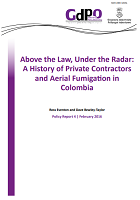
Ross Eventon & Dave Bewley-Taylor
The employment of private military and security companies (PMSCs) to carry out government policies has grown exponentially over the past two decades. Conventional explanations for this rise, such as cost-saving and down-sizing, do not appear convincing, given the evidence. Instead, it seems national governments are paying a premium to enjoy two major benefits of outsourcing: secrecy and a lack of accountability. Aerial fumigation of illicit crops in Colombia, backed financially, diplomatically and logistically by Washington, is a case in point. The ineffective policy is of dubious legality, causes damage to people and the environment, and would, if carried out by US military forces, imply the direct involvement of the US in Colombia’s civil war, thereby triggering the application of international law as it applies to armed conflict. Moreover, there is substantial evidence suggesting that fumigation, while failing in its officially declared goals, does achieve strategic objectives for Washington and Bogota through the displacement of the rural population from areas of insurgent influence. For Colombia, the presence of foreign contractors has implied a significant undermining of national sovereignty. In addition, it has removed any viable recourse for citizens subject to human rights violations by contractors - whether during the course of fumigation operations or otherwise.
Read the full report here: Above the Law, Under the Radar
Demystifying Narcoterrorism
GDPO Policy Brief 9, May 2015
Benoît Gomis
Although the term ‘narcoterrorism’ emerged in the early 1980s to describe the attacks by the Shining Path and the Revolutionary Armed Forces of Colombia (FARC) against counternarcotics police, its meaning has expanded and lost clarity since then, while the term gained significant traction after September 11th 2001. The term is problematic in that it suggests a ‘symbiotic relationship’ between drug traffickers and terrorists that is very rarely confirmed by evidence, as the case studies of Peru, Afghanistan, Mali and Mexico demonstrate. ‘Narcoterrorism’ is a red herring as it diverts attention away from other important issues, such as corruption, state abuses, arms trafficking, human trafficking and other types of organised crime and violence. This simplistic label often overestimates the importance of the drug trade in funding terrorism, and of the use of terrorist tactics by drug traffickers. Drug trafficking and other types of illicit trade and organised crime are important issues in their own right, and should not need the ‘terrorism’ label to attract attention. While simplifying complex problems may be appealing, it may lead to ineffective and at times counterproductive policy responses.
Justifying Militarisation; ‘Counter-Narcotics’ and ‘Counter Narco-Terrorism’

Ross Eventon
Three inter-related developments within US foreign policy have emerged in recent years: the militarisation of Central America states under the auspices of confronting drug trafficking organisations and improving human security; the deployment of militarised DEA agents overseas; and the emergence of ‘counter narco-terrorism’ as a means of justifying such policies. Linking these developments is the use by US officials of ‘counter narco-terrorism’ as a justification for chosen policies. In Afghanistan, FAST has been touted as such a programme - regardless of the fact that Washington does not officially consider the Taliban a terrorist group. In Central America, officials have publicly offered the same explanation for their policies without providing any substantiating evidence. A strenuous effort to generate such a connection appears to be underway, whether any link exists in reality or not. It is too easy to say ‘counter-narcotics’ operations are failing or misguided. Washington’s policies in Central America may well have disastrous results for many, but through the maintenance of a certain status quo and the improvement of the climate for business and investment, they are undoubtedly a success for others.
Read the full report here: Justifying Militarisation

